Analysis of Tax Incentives for Research and Development
VerifiedAdded on 2020/05/16
|11
|2812
|31
Report
AI Summary
This report examines the tax incentives available to companies for research and development (R&D) activities. It defines R&D, highlighting its importance in improving products and production methods. The report details tax incentives, such as deductions for R&D expenditure, including specific percentages and eligibility criteria, and the implications of these incentives, such as improved operating efficiency, enhanced business performance, and the importance of maintaining proper records. The report references the Income Tax Assessment Act 1936 and relevant tax rulings, specifically TR 92/2, outlining the provisions and rules governing tax deductions for R&D expenditure. The report also categorizes R&D expenditure and discusses the types of expenses that qualify for deductions, emphasizing the impact of these incentives on encouraging innovation and improving product quality. The report concludes by summarizing the key implications of these tax incentives on business entities.
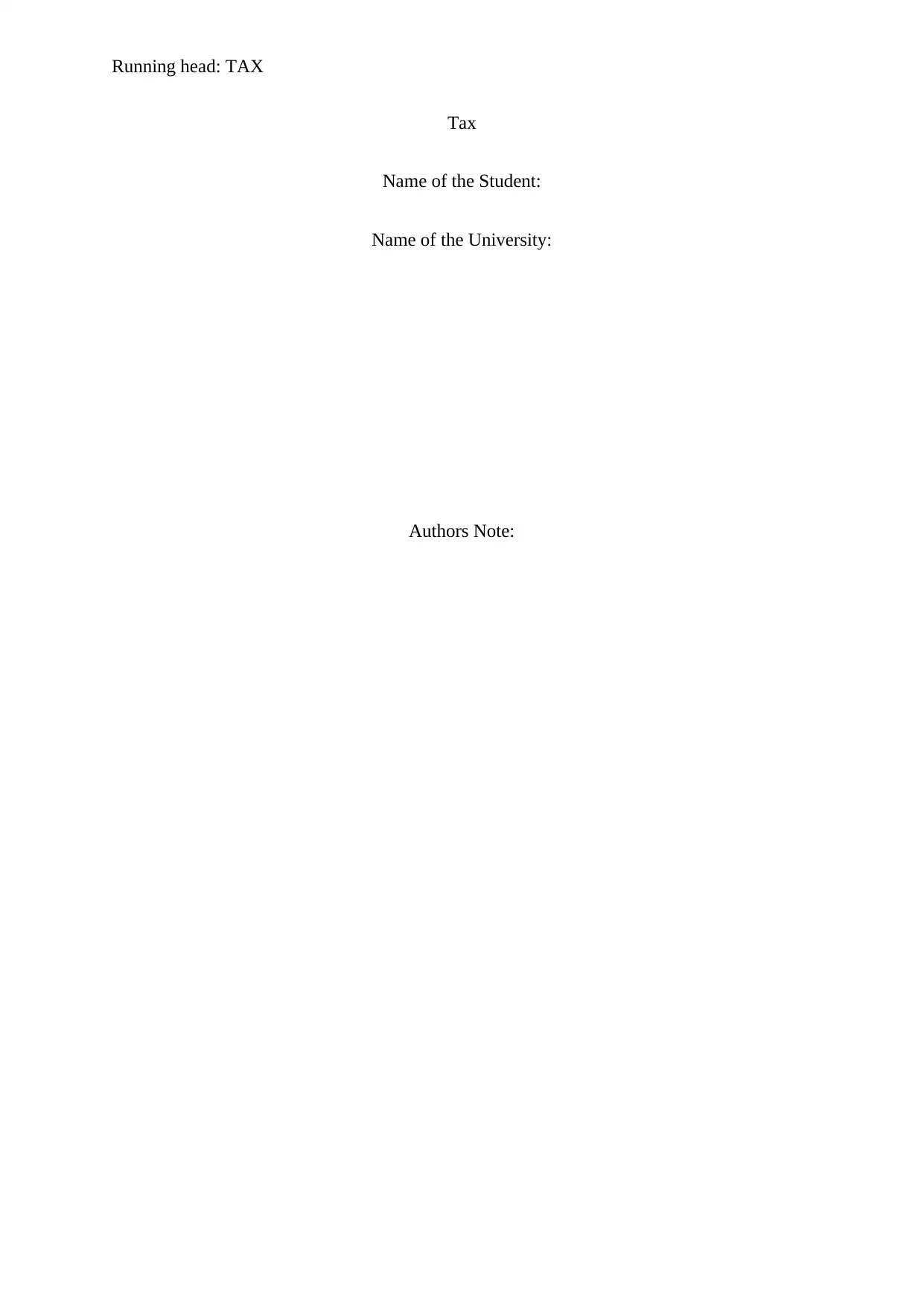
Running head: TAX
Tax
Name of the Student:
Name of the University:
Authors Note:
Tax
Name of the Student:
Name of the University:
Authors Note:
Paraphrase This Document
Need a fresh take? Get an instant paraphrase of this document with our AI Paraphraser
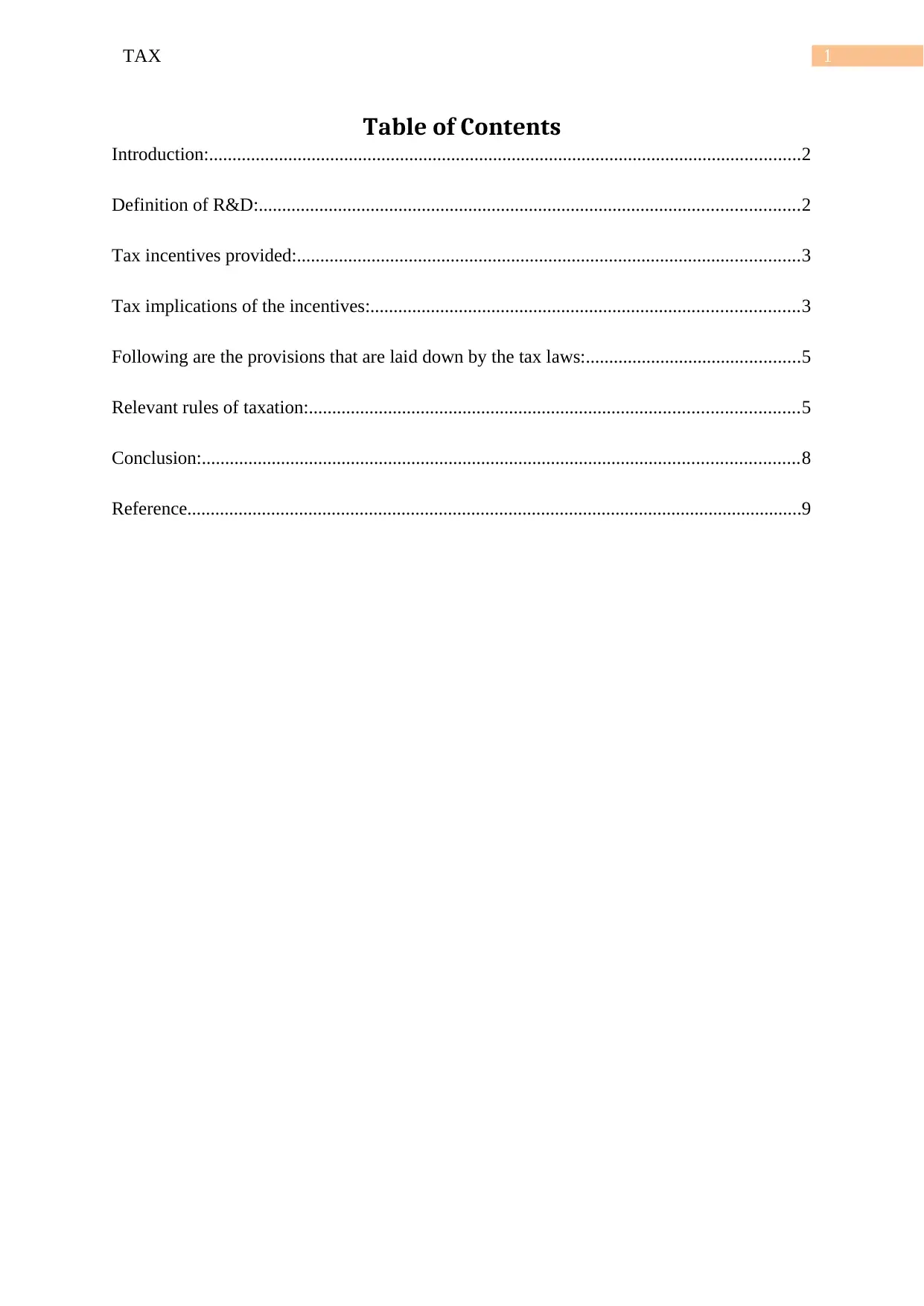
1TAX
Table of Contents
Introduction:...............................................................................................................................2
Definition of R&D:....................................................................................................................2
Tax incentives provided:............................................................................................................3
Tax implications of the incentives:............................................................................................3
Following are the provisions that are laid down by the tax laws:..............................................5
Relevant rules of taxation:.........................................................................................................5
Conclusion:................................................................................................................................8
Reference....................................................................................................................................9
Table of Contents
Introduction:...............................................................................................................................2
Definition of R&D:....................................................................................................................2
Tax incentives provided:............................................................................................................3
Tax implications of the incentives:............................................................................................3
Following are the provisions that are laid down by the tax laws:..............................................5
Relevant rules of taxation:.........................................................................................................5
Conclusion:................................................................................................................................8
Reference....................................................................................................................................9
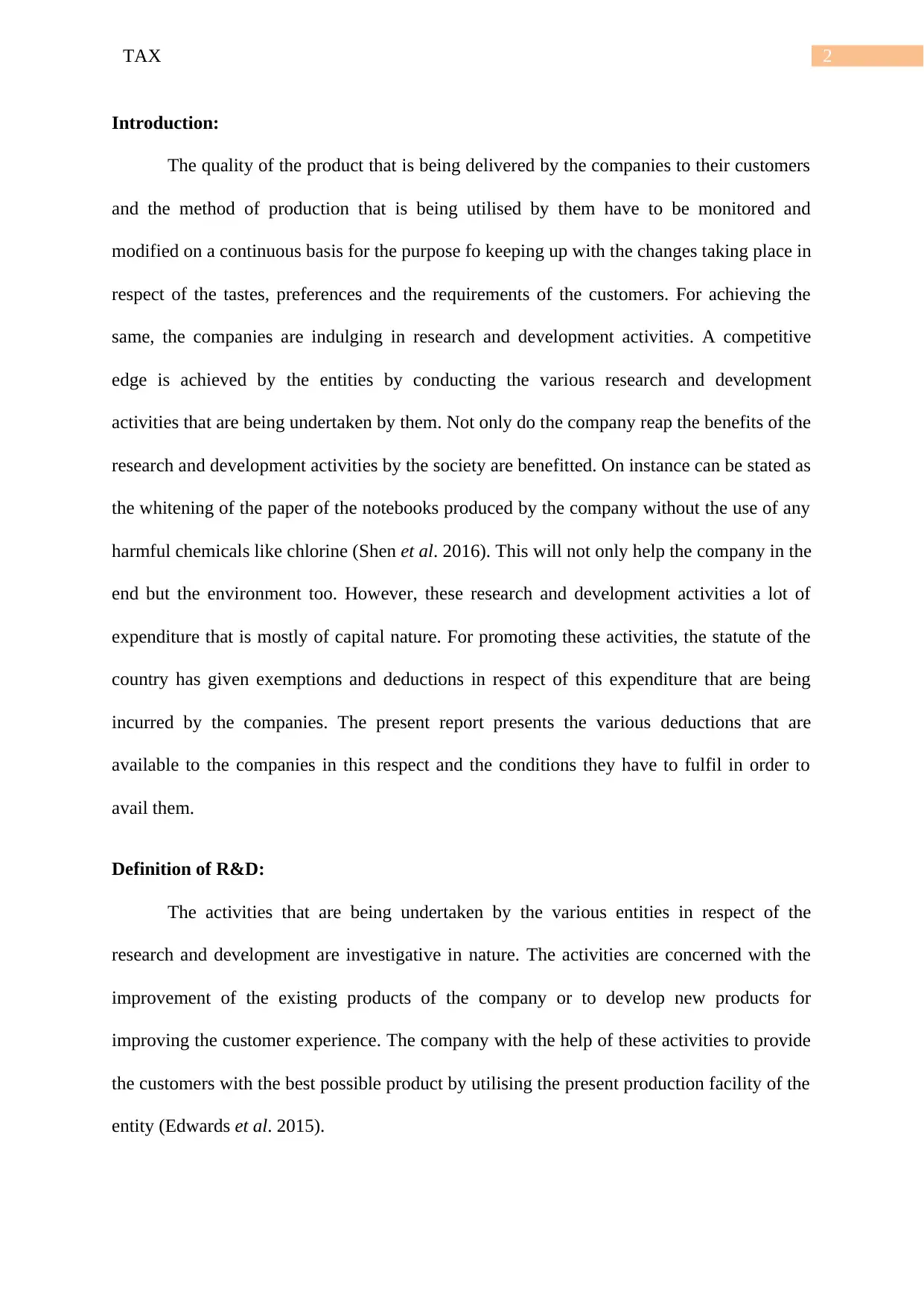
2TAX
Introduction:
The quality of the product that is being delivered by the companies to their customers
and the method of production that is being utilised by them have to be monitored and
modified on a continuous basis for the purpose fo keeping up with the changes taking place in
respect of the tastes, preferences and the requirements of the customers. For achieving the
same, the companies are indulging in research and development activities. A competitive
edge is achieved by the entities by conducting the various research and development
activities that are being undertaken by them. Not only do the company reap the benefits of the
research and development activities by the society are benefitted. On instance can be stated as
the whitening of the paper of the notebooks produced by the company without the use of any
harmful chemicals like chlorine (Shen et al. 2016). This will not only help the company in the
end but the environment too. However, these research and development activities a lot of
expenditure that is mostly of capital nature. For promoting these activities, the statute of the
country has given exemptions and deductions in respect of this expenditure that are being
incurred by the companies. The present report presents the various deductions that are
available to the companies in this respect and the conditions they have to fulfil in order to
avail them.
Definition of R&D:
The activities that are being undertaken by the various entities in respect of the
research and development are investigative in nature. The activities are concerned with the
improvement of the existing products of the company or to develop new products for
improving the customer experience. The company with the help of these activities to provide
the customers with the best possible product by utilising the present production facility of the
entity (Edwards et al. 2015).
Introduction:
The quality of the product that is being delivered by the companies to their customers
and the method of production that is being utilised by them have to be monitored and
modified on a continuous basis for the purpose fo keeping up with the changes taking place in
respect of the tastes, preferences and the requirements of the customers. For achieving the
same, the companies are indulging in research and development activities. A competitive
edge is achieved by the entities by conducting the various research and development
activities that are being undertaken by them. Not only do the company reap the benefits of the
research and development activities by the society are benefitted. On instance can be stated as
the whitening of the paper of the notebooks produced by the company without the use of any
harmful chemicals like chlorine (Shen et al. 2016). This will not only help the company in the
end but the environment too. However, these research and development activities a lot of
expenditure that is mostly of capital nature. For promoting these activities, the statute of the
country has given exemptions and deductions in respect of this expenditure that are being
incurred by the companies. The present report presents the various deductions that are
available to the companies in this respect and the conditions they have to fulfil in order to
avail them.
Definition of R&D:
The activities that are being undertaken by the various entities in respect of the
research and development are investigative in nature. The activities are concerned with the
improvement of the existing products of the company or to develop new products for
improving the customer experience. The company with the help of these activities to provide
the customers with the best possible product by utilising the present production facility of the
entity (Edwards et al. 2015).
⊘ This is a preview!⊘
Do you want full access?
Subscribe today to unlock all pages.

Trusted by 1+ million students worldwide
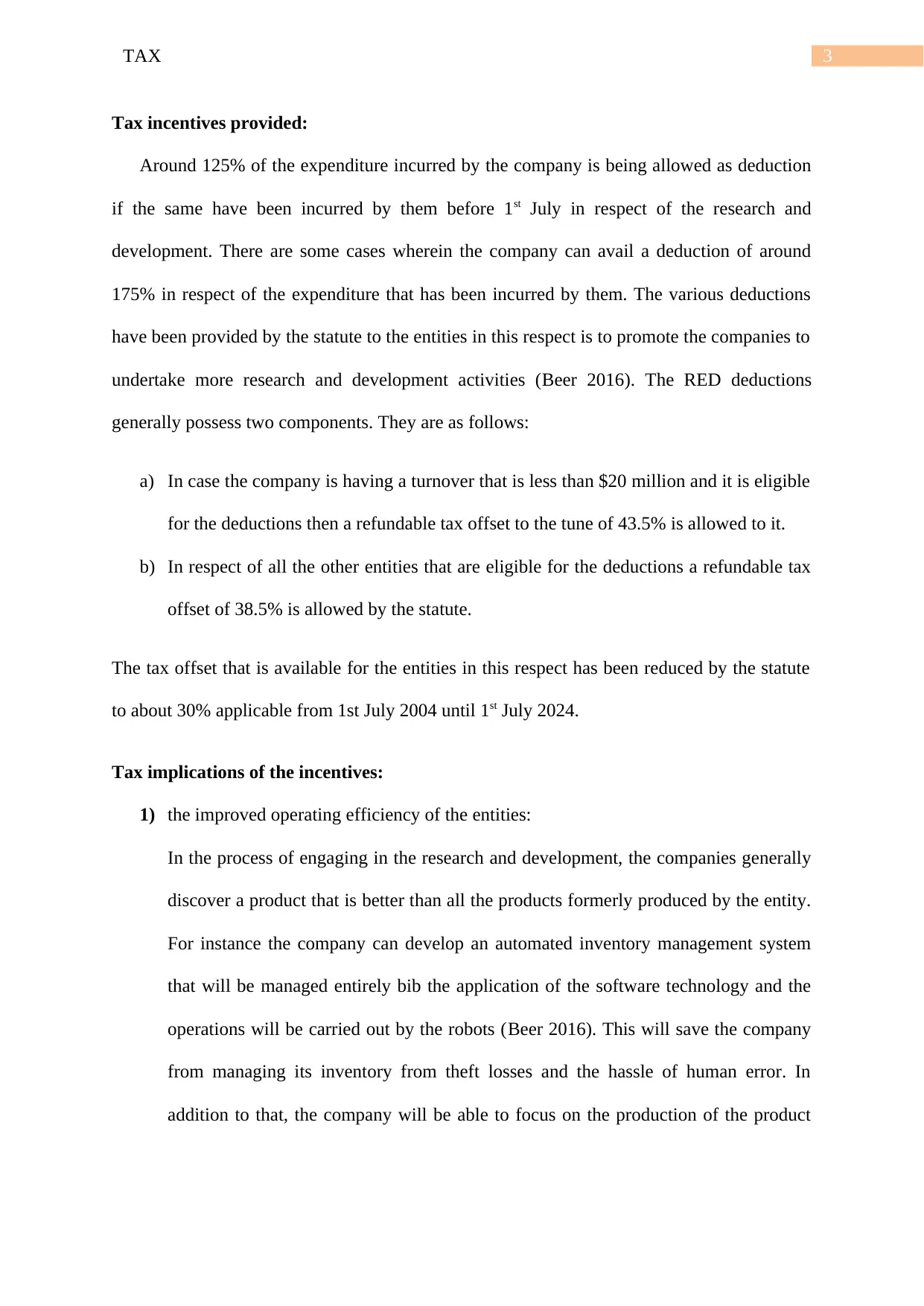
3TAX
Tax incentives provided:
Around 125% of the expenditure incurred by the company is being allowed as deduction
if the same have been incurred by them before 1st July in respect of the research and
development. There are some cases wherein the company can avail a deduction of around
175% in respect of the expenditure that has been incurred by them. The various deductions
have been provided by the statute to the entities in this respect is to promote the companies to
undertake more research and development activities (Beer 2016). The RED deductions
generally possess two components. They are as follows:
a) In case the company is having a turnover that is less than $20 million and it is eligible
for the deductions then a refundable tax offset to the tune of 43.5% is allowed to it.
b) In respect of all the other entities that are eligible for the deductions a refundable tax
offset of 38.5% is allowed by the statute.
The tax offset that is available for the entities in this respect has been reduced by the statute
to about 30% applicable from 1st July 2004 until 1st July 2024.
Tax implications of the incentives:
1) the improved operating efficiency of the entities:
In the process of engaging in the research and development, the companies generally
discover a product that is better than all the products formerly produced by the entity.
For instance the company can develop an automated inventory management system
that will be managed entirely bib the application of the software technology and the
operations will be carried out by the robots (Beer 2016). This will save the company
from managing its inventory from theft losses and the hassle of human error. In
addition to that, the company will be able to focus on the production of the product
Tax incentives provided:
Around 125% of the expenditure incurred by the company is being allowed as deduction
if the same have been incurred by them before 1st July in respect of the research and
development. There are some cases wherein the company can avail a deduction of around
175% in respect of the expenditure that has been incurred by them. The various deductions
have been provided by the statute to the entities in this respect is to promote the companies to
undertake more research and development activities (Beer 2016). The RED deductions
generally possess two components. They are as follows:
a) In case the company is having a turnover that is less than $20 million and it is eligible
for the deductions then a refundable tax offset to the tune of 43.5% is allowed to it.
b) In respect of all the other entities that are eligible for the deductions a refundable tax
offset of 38.5% is allowed by the statute.
The tax offset that is available for the entities in this respect has been reduced by the statute
to about 30% applicable from 1st July 2004 until 1st July 2024.
Tax implications of the incentives:
1) the improved operating efficiency of the entities:
In the process of engaging in the research and development, the companies generally
discover a product that is better than all the products formerly produced by the entity.
For instance the company can develop an automated inventory management system
that will be managed entirely bib the application of the software technology and the
operations will be carried out by the robots (Beer 2016). This will save the company
from managing its inventory from theft losses and the hassle of human error. In
addition to that, the company will be able to focus on the production of the product
Paraphrase This Document
Need a fresh take? Get an instant paraphrase of this document with our AI Paraphraser
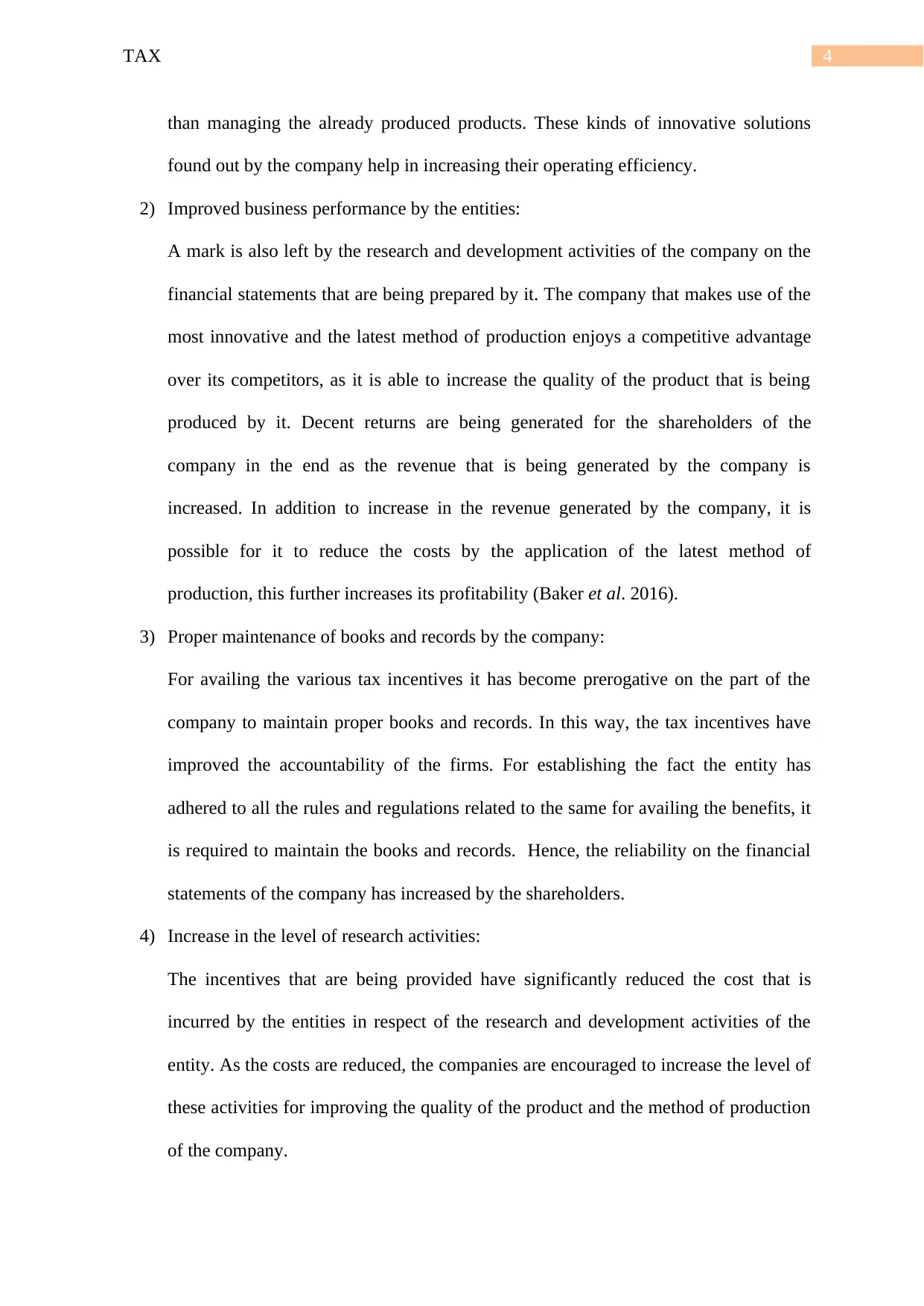
4TAX
than managing the already produced products. These kinds of innovative solutions
found out by the company help in increasing their operating efficiency.
2) Improved business performance by the entities:
A mark is also left by the research and development activities of the company on the
financial statements that are being prepared by it. The company that makes use of the
most innovative and the latest method of production enjoys a competitive advantage
over its competitors, as it is able to increase the quality of the product that is being
produced by it. Decent returns are being generated for the shareholders of the
company in the end as the revenue that is being generated by the company is
increased. In addition to increase in the revenue generated by the company, it is
possible for it to reduce the costs by the application of the latest method of
production, this further increases its profitability (Baker et al. 2016).
3) Proper maintenance of books and records by the company:
For availing the various tax incentives it has become prerogative on the part of the
company to maintain proper books and records. In this way, the tax incentives have
improved the accountability of the firms. For establishing the fact the entity has
adhered to all the rules and regulations related to the same for availing the benefits, it
is required to maintain the books and records. Hence, the reliability on the financial
statements of the company has increased by the shareholders.
4) Increase in the level of research activities:
The incentives that are being provided have significantly reduced the cost that is
incurred by the entities in respect of the research and development activities of the
entity. As the costs are reduced, the companies are encouraged to increase the level of
these activities for improving the quality of the product and the method of production
of the company.
than managing the already produced products. These kinds of innovative solutions
found out by the company help in increasing their operating efficiency.
2) Improved business performance by the entities:
A mark is also left by the research and development activities of the company on the
financial statements that are being prepared by it. The company that makes use of the
most innovative and the latest method of production enjoys a competitive advantage
over its competitors, as it is able to increase the quality of the product that is being
produced by it. Decent returns are being generated for the shareholders of the
company in the end as the revenue that is being generated by the company is
increased. In addition to increase in the revenue generated by the company, it is
possible for it to reduce the costs by the application of the latest method of
production, this further increases its profitability (Baker et al. 2016).
3) Proper maintenance of books and records by the company:
For availing the various tax incentives it has become prerogative on the part of the
company to maintain proper books and records. In this way, the tax incentives have
improved the accountability of the firms. For establishing the fact the entity has
adhered to all the rules and regulations related to the same for availing the benefits, it
is required to maintain the books and records. Hence, the reliability on the financial
statements of the company has increased by the shareholders.
4) Increase in the level of research activities:
The incentives that are being provided have significantly reduced the cost that is
incurred by the entities in respect of the research and development activities of the
entity. As the costs are reduced, the companies are encouraged to increase the level of
these activities for improving the quality of the product and the method of production
of the company.
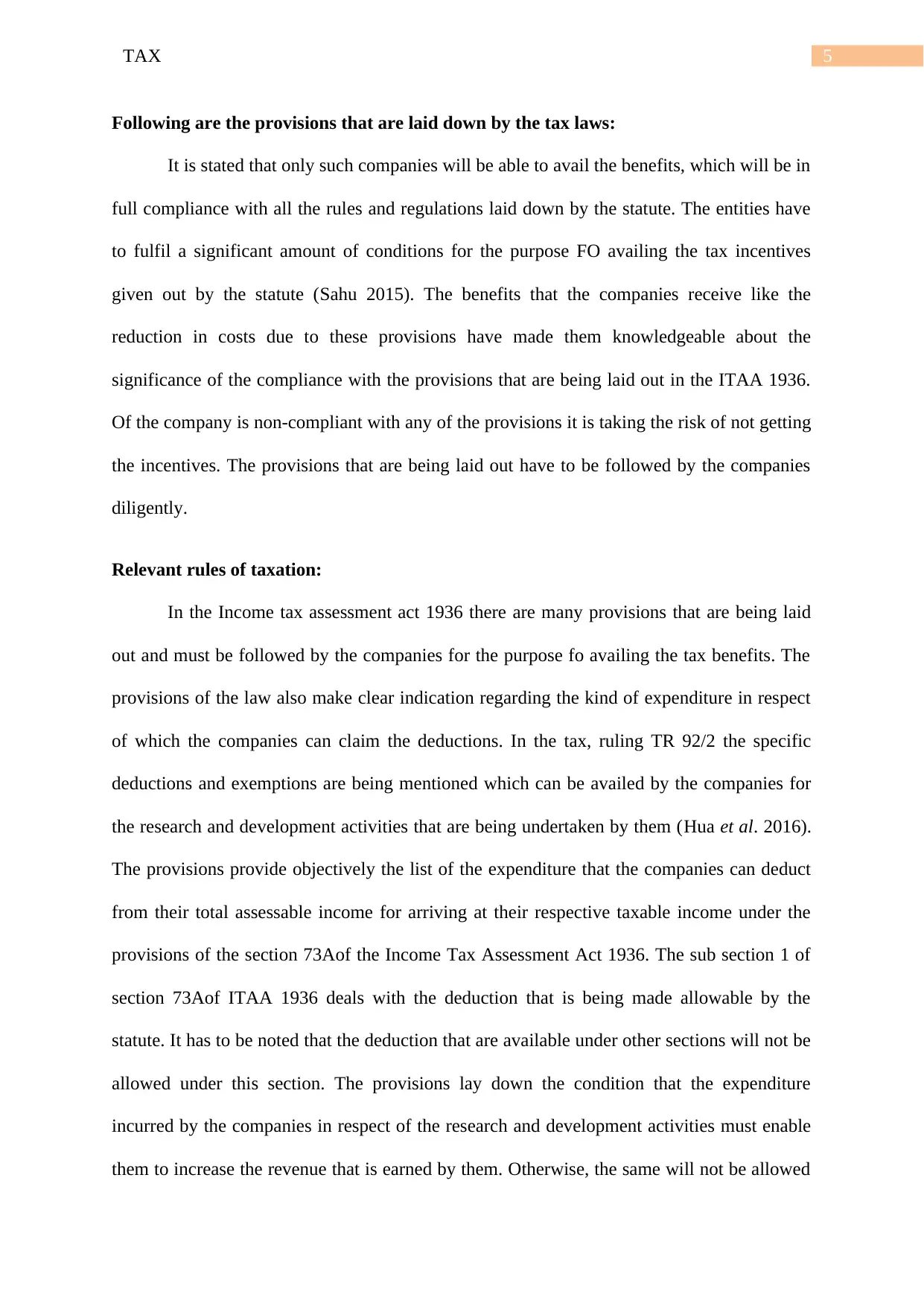
5TAX
Following are the provisions that are laid down by the tax laws:
It is stated that only such companies will be able to avail the benefits, which will be in
full compliance with all the rules and regulations laid down by the statute. The entities have
to fulfil a significant amount of conditions for the purpose FO availing the tax incentives
given out by the statute (Sahu 2015). The benefits that the companies receive like the
reduction in costs due to these provisions have made them knowledgeable about the
significance of the compliance with the provisions that are being laid out in the ITAA 1936.
Of the company is non-compliant with any of the provisions it is taking the risk of not getting
the incentives. The provisions that are being laid out have to be followed by the companies
diligently.
Relevant rules of taxation:
In the Income tax assessment act 1936 there are many provisions that are being laid
out and must be followed by the companies for the purpose fo availing the tax benefits. The
provisions of the law also make clear indication regarding the kind of expenditure in respect
of which the companies can claim the deductions. In the tax, ruling TR 92/2 the specific
deductions and exemptions are being mentioned which can be availed by the companies for
the research and development activities that are being undertaken by them (Hua et al. 2016).
The provisions provide objectively the list of the expenditure that the companies can deduct
from their total assessable income for arriving at their respective taxable income under the
provisions of the section 73Aof the Income Tax Assessment Act 1936. The sub section 1 of
section 73Aof ITAA 1936 deals with the deduction that is being made allowable by the
statute. It has to be noted that the deduction that are available under other sections will not be
allowed under this section. The provisions lay down the condition that the expenditure
incurred by the companies in respect of the research and development activities must enable
them to increase the revenue that is earned by them. Otherwise, the same will not be allowed
Following are the provisions that are laid down by the tax laws:
It is stated that only such companies will be able to avail the benefits, which will be in
full compliance with all the rules and regulations laid down by the statute. The entities have
to fulfil a significant amount of conditions for the purpose FO availing the tax incentives
given out by the statute (Sahu 2015). The benefits that the companies receive like the
reduction in costs due to these provisions have made them knowledgeable about the
significance of the compliance with the provisions that are being laid out in the ITAA 1936.
Of the company is non-compliant with any of the provisions it is taking the risk of not getting
the incentives. The provisions that are being laid out have to be followed by the companies
diligently.
Relevant rules of taxation:
In the Income tax assessment act 1936 there are many provisions that are being laid
out and must be followed by the companies for the purpose fo availing the tax benefits. The
provisions of the law also make clear indication regarding the kind of expenditure in respect
of which the companies can claim the deductions. In the tax, ruling TR 92/2 the specific
deductions and exemptions are being mentioned which can be availed by the companies for
the research and development activities that are being undertaken by them (Hua et al. 2016).
The provisions provide objectively the list of the expenditure that the companies can deduct
from their total assessable income for arriving at their respective taxable income under the
provisions of the section 73Aof the Income Tax Assessment Act 1936. The sub section 1 of
section 73Aof ITAA 1936 deals with the deduction that is being made allowable by the
statute. It has to be noted that the deduction that are available under other sections will not be
allowed under this section. The provisions lay down the condition that the expenditure
incurred by the companies in respect of the research and development activities must enable
them to increase the revenue that is earned by them. Otherwise, the same will not be allowed
⊘ This is a preview!⊘
Do you want full access?
Subscribe today to unlock all pages.

Trusted by 1+ million students worldwide
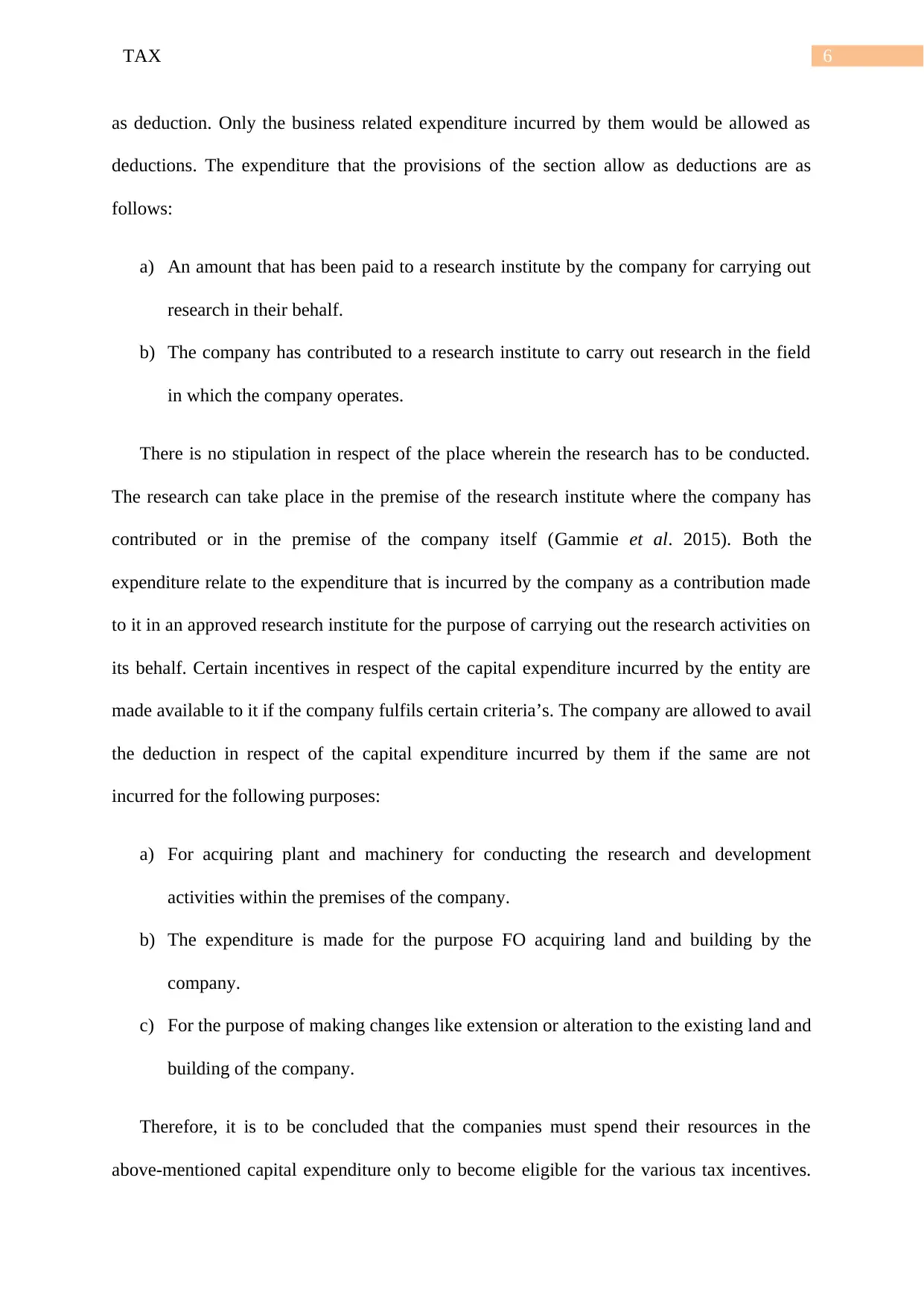
6TAX
as deduction. Only the business related expenditure incurred by them would be allowed as
deductions. The expenditure that the provisions of the section allow as deductions are as
follows:
a) An amount that has been paid to a research institute by the company for carrying out
research in their behalf.
b) The company has contributed to a research institute to carry out research in the field
in which the company operates.
There is no stipulation in respect of the place wherein the research has to be conducted.
The research can take place in the premise of the research institute where the company has
contributed or in the premise of the company itself (Gammie et al. 2015). Both the
expenditure relate to the expenditure that is incurred by the company as a contribution made
to it in an approved research institute for the purpose of carrying out the research activities on
its behalf. Certain incentives in respect of the capital expenditure incurred by the entity are
made available to it if the company fulfils certain criteria’s. The company are allowed to avail
the deduction in respect of the capital expenditure incurred by them if the same are not
incurred for the following purposes:
a) For acquiring plant and machinery for conducting the research and development
activities within the premises of the company.
b) The expenditure is made for the purpose FO acquiring land and building by the
company.
c) For the purpose of making changes like extension or alteration to the existing land and
building of the company.
Therefore, it is to be concluded that the companies must spend their resources in the
above-mentioned capital expenditure only to become eligible for the various tax incentives.
as deduction. Only the business related expenditure incurred by them would be allowed as
deductions. The expenditure that the provisions of the section allow as deductions are as
follows:
a) An amount that has been paid to a research institute by the company for carrying out
research in their behalf.
b) The company has contributed to a research institute to carry out research in the field
in which the company operates.
There is no stipulation in respect of the place wherein the research has to be conducted.
The research can take place in the premise of the research institute where the company has
contributed or in the premise of the company itself (Gammie et al. 2015). Both the
expenditure relate to the expenditure that is incurred by the company as a contribution made
to it in an approved research institute for the purpose of carrying out the research activities on
its behalf. Certain incentives in respect of the capital expenditure incurred by the entity are
made available to it if the company fulfils certain criteria’s. The company are allowed to avail
the deduction in respect of the capital expenditure incurred by them if the same are not
incurred for the following purposes:
a) For acquiring plant and machinery for conducting the research and development
activities within the premises of the company.
b) The expenditure is made for the purpose FO acquiring land and building by the
company.
c) For the purpose of making changes like extension or alteration to the existing land and
building of the company.
Therefore, it is to be concluded that the companies must spend their resources in the
above-mentioned capital expenditure only to become eligible for the various tax incentives.
Paraphrase This Document
Need a fresh take? Get an instant paraphrase of this document with our AI Paraphraser
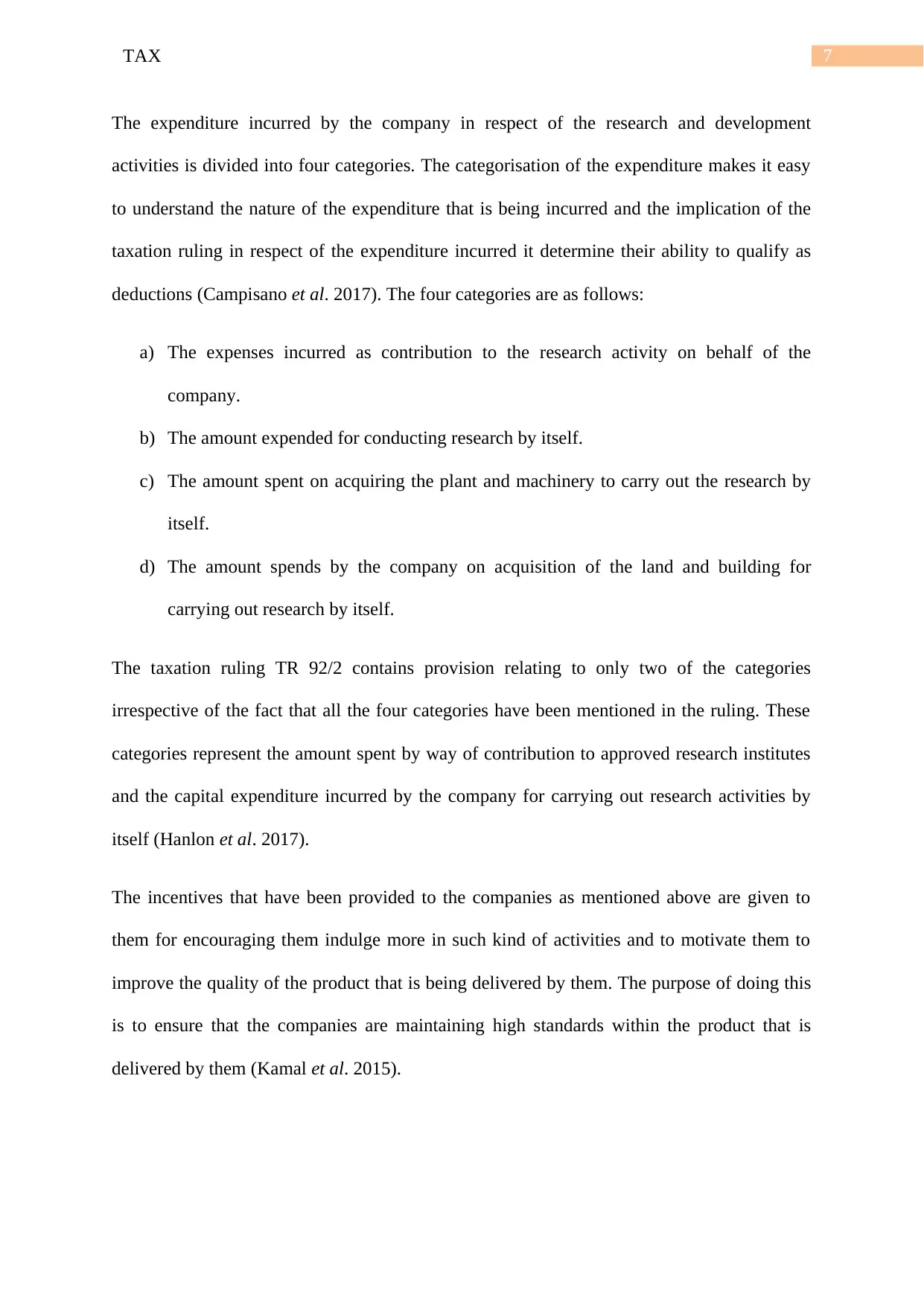
7TAX
The expenditure incurred by the company in respect of the research and development
activities is divided into four categories. The categorisation of the expenditure makes it easy
to understand the nature of the expenditure that is being incurred and the implication of the
taxation ruling in respect of the expenditure incurred it determine their ability to qualify as
deductions (Campisano et al. 2017). The four categories are as follows:
a) The expenses incurred as contribution to the research activity on behalf of the
company.
b) The amount expended for conducting research by itself.
c) The amount spent on acquiring the plant and machinery to carry out the research by
itself.
d) The amount spends by the company on acquisition of the land and building for
carrying out research by itself.
The taxation ruling TR 92/2 contains provision relating to only two of the categories
irrespective of the fact that all the four categories have been mentioned in the ruling. These
categories represent the amount spent by way of contribution to approved research institutes
and the capital expenditure incurred by the company for carrying out research activities by
itself (Hanlon et al. 2017).
The incentives that have been provided to the companies as mentioned above are given to
them for encouraging them indulge more in such kind of activities and to motivate them to
improve the quality of the product that is being delivered by them. The purpose of doing this
is to ensure that the companies are maintaining high standards within the product that is
delivered by them (Kamal et al. 2015).
The expenditure incurred by the company in respect of the research and development
activities is divided into four categories. The categorisation of the expenditure makes it easy
to understand the nature of the expenditure that is being incurred and the implication of the
taxation ruling in respect of the expenditure incurred it determine their ability to qualify as
deductions (Campisano et al. 2017). The four categories are as follows:
a) The expenses incurred as contribution to the research activity on behalf of the
company.
b) The amount expended for conducting research by itself.
c) The amount spent on acquiring the plant and machinery to carry out the research by
itself.
d) The amount spends by the company on acquisition of the land and building for
carrying out research by itself.
The taxation ruling TR 92/2 contains provision relating to only two of the categories
irrespective of the fact that all the four categories have been mentioned in the ruling. These
categories represent the amount spent by way of contribution to approved research institutes
and the capital expenditure incurred by the company for carrying out research activities by
itself (Hanlon et al. 2017).
The incentives that have been provided to the companies as mentioned above are given to
them for encouraging them indulge more in such kind of activities and to motivate them to
improve the quality of the product that is being delivered by them. The purpose of doing this
is to ensure that the companies are maintaining high standards within the product that is
delivered by them (Kamal et al. 2015).
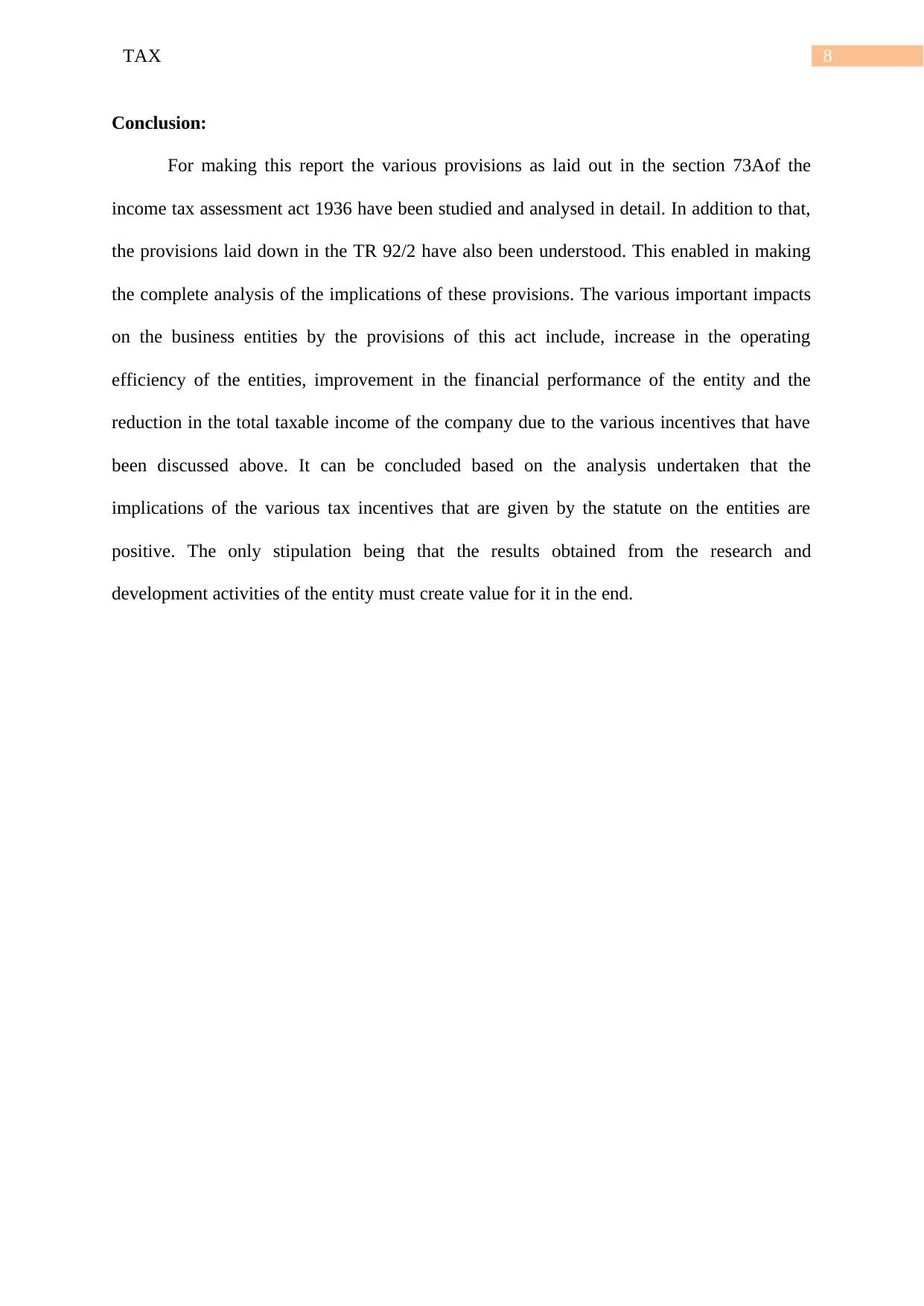
8TAX
Conclusion:
For making this report the various provisions as laid out in the section 73Aof the
income tax assessment act 1936 have been studied and analysed in detail. In addition to that,
the provisions laid down in the TR 92/2 have also been understood. This enabled in making
the complete analysis of the implications of these provisions. The various important impacts
on the business entities by the provisions of this act include, increase in the operating
efficiency of the entities, improvement in the financial performance of the entity and the
reduction in the total taxable income of the company due to the various incentives that have
been discussed above. It can be concluded based on the analysis undertaken that the
implications of the various tax incentives that are given by the statute on the entities are
positive. The only stipulation being that the results obtained from the research and
development activities of the entity must create value for it in the end.
Conclusion:
For making this report the various provisions as laid out in the section 73Aof the
income tax assessment act 1936 have been studied and analysed in detail. In addition to that,
the provisions laid down in the TR 92/2 have also been understood. This enabled in making
the complete analysis of the implications of these provisions. The various important impacts
on the business entities by the provisions of this act include, increase in the operating
efficiency of the entities, improvement in the financial performance of the entity and the
reduction in the total taxable income of the company due to the various incentives that have
been discussed above. It can be concluded based on the analysis undertaken that the
implications of the various tax incentives that are given by the statute on the entities are
positive. The only stipulation being that the results obtained from the research and
development activities of the entity must create value for it in the end.
⊘ This is a preview!⊘
Do you want full access?
Subscribe today to unlock all pages.

Trusted by 1+ million students worldwide
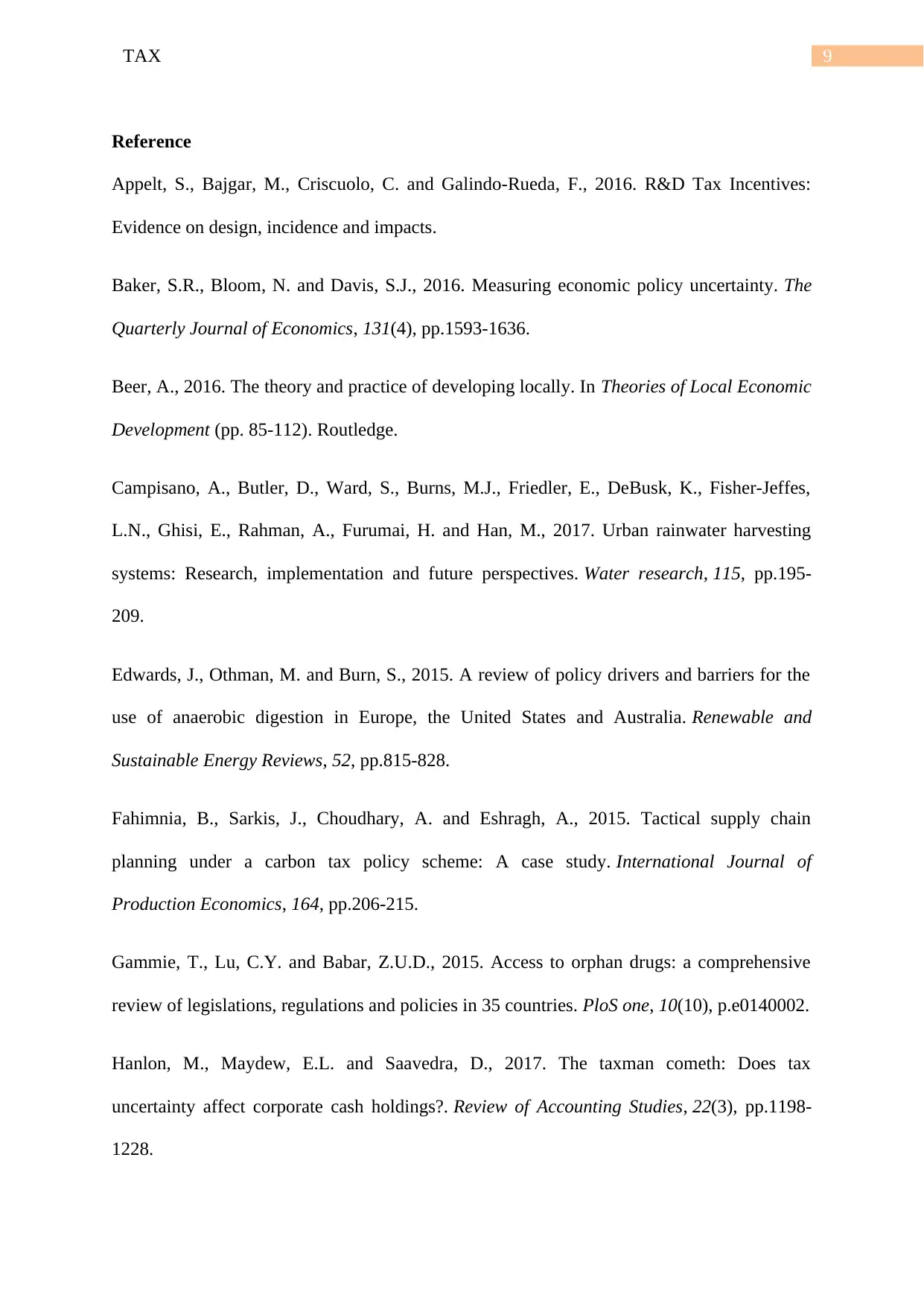
9TAX
Reference
Appelt, S., Bajgar, M., Criscuolo, C. and Galindo-Rueda, F., 2016. R&D Tax Incentives:
Evidence on design, incidence and impacts.
Baker, S.R., Bloom, N. and Davis, S.J., 2016. Measuring economic policy uncertainty. The
Quarterly Journal of Economics, 131(4), pp.1593-1636.
Beer, A., 2016. The theory and practice of developing locally. In Theories of Local Economic
Development (pp. 85-112). Routledge.
Campisano, A., Butler, D., Ward, S., Burns, M.J., Friedler, E., DeBusk, K., Fisher-Jeffes,
L.N., Ghisi, E., Rahman, A., Furumai, H. and Han, M., 2017. Urban rainwater harvesting
systems: Research, implementation and future perspectives. Water research, 115, pp.195-
209.
Edwards, J., Othman, M. and Burn, S., 2015. A review of policy drivers and barriers for the
use of anaerobic digestion in Europe, the United States and Australia. Renewable and
Sustainable Energy Reviews, 52, pp.815-828.
Fahimnia, B., Sarkis, J., Choudhary, A. and Eshragh, A., 2015. Tactical supply chain
planning under a carbon tax policy scheme: A case study. International Journal of
Production Economics, 164, pp.206-215.
Gammie, T., Lu, C.Y. and Babar, Z.U.D., 2015. Access to orphan drugs: a comprehensive
review of legislations, regulations and policies in 35 countries. PloS one, 10(10), p.e0140002.
Hanlon, M., Maydew, E.L. and Saavedra, D., 2017. The taxman cometh: Does tax
uncertainty affect corporate cash holdings?. Review of Accounting Studies, 22(3), pp.1198-
1228.
Reference
Appelt, S., Bajgar, M., Criscuolo, C. and Galindo-Rueda, F., 2016. R&D Tax Incentives:
Evidence on design, incidence and impacts.
Baker, S.R., Bloom, N. and Davis, S.J., 2016. Measuring economic policy uncertainty. The
Quarterly Journal of Economics, 131(4), pp.1593-1636.
Beer, A., 2016. The theory and practice of developing locally. In Theories of Local Economic
Development (pp. 85-112). Routledge.
Campisano, A., Butler, D., Ward, S., Burns, M.J., Friedler, E., DeBusk, K., Fisher-Jeffes,
L.N., Ghisi, E., Rahman, A., Furumai, H. and Han, M., 2017. Urban rainwater harvesting
systems: Research, implementation and future perspectives. Water research, 115, pp.195-
209.
Edwards, J., Othman, M. and Burn, S., 2015. A review of policy drivers and barriers for the
use of anaerobic digestion in Europe, the United States and Australia. Renewable and
Sustainable Energy Reviews, 52, pp.815-828.
Fahimnia, B., Sarkis, J., Choudhary, A. and Eshragh, A., 2015. Tactical supply chain
planning under a carbon tax policy scheme: A case study. International Journal of
Production Economics, 164, pp.206-215.
Gammie, T., Lu, C.Y. and Babar, Z.U.D., 2015. Access to orphan drugs: a comprehensive
review of legislations, regulations and policies in 35 countries. PloS one, 10(10), p.e0140002.
Hanlon, M., Maydew, E.L. and Saavedra, D., 2017. The taxman cometh: Does tax
uncertainty affect corporate cash holdings?. Review of Accounting Studies, 22(3), pp.1198-
1228.
Paraphrase This Document
Need a fresh take? Get an instant paraphrase of this document with our AI Paraphraser
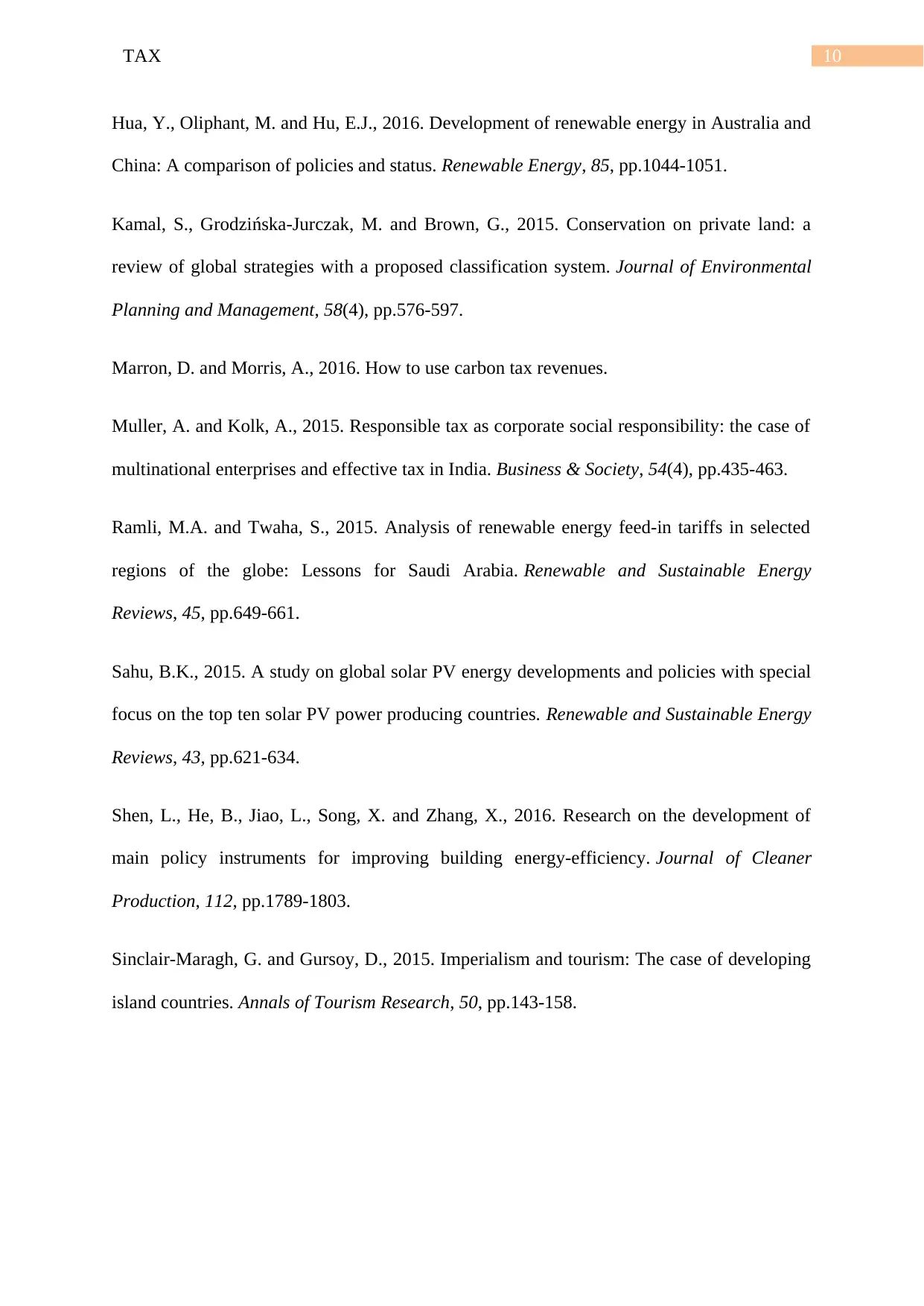
10TAX
Hua, Y., Oliphant, M. and Hu, E.J., 2016. Development of renewable energy in Australia and
China: A comparison of policies and status. Renewable Energy, 85, pp.1044-1051.
Kamal, S., Grodzińska-Jurczak, M. and Brown, G., 2015. Conservation on private land: a
review of global strategies with a proposed classification system. Journal of Environmental
Planning and Management, 58(4), pp.576-597.
Marron, D. and Morris, A., 2016. How to use carbon tax revenues.
Muller, A. and Kolk, A., 2015. Responsible tax as corporate social responsibility: the case of
multinational enterprises and effective tax in India. Business & Society, 54(4), pp.435-463.
Ramli, M.A. and Twaha, S., 2015. Analysis of renewable energy feed-in tariffs in selected
regions of the globe: Lessons for Saudi Arabia. Renewable and Sustainable Energy
Reviews, 45, pp.649-661.
Sahu, B.K., 2015. A study on global solar PV energy developments and policies with special
focus on the top ten solar PV power producing countries. Renewable and Sustainable Energy
Reviews, 43, pp.621-634.
Shen, L., He, B., Jiao, L., Song, X. and Zhang, X., 2016. Research on the development of
main policy instruments for improving building energy-efficiency. Journal of Cleaner
Production, 112, pp.1789-1803.
Sinclair-Maragh, G. and Gursoy, D., 2015. Imperialism and tourism: The case of developing
island countries. Annals of Tourism Research, 50, pp.143-158.
Hua, Y., Oliphant, M. and Hu, E.J., 2016. Development of renewable energy in Australia and
China: A comparison of policies and status. Renewable Energy, 85, pp.1044-1051.
Kamal, S., Grodzińska-Jurczak, M. and Brown, G., 2015. Conservation on private land: a
review of global strategies with a proposed classification system. Journal of Environmental
Planning and Management, 58(4), pp.576-597.
Marron, D. and Morris, A., 2016. How to use carbon tax revenues.
Muller, A. and Kolk, A., 2015. Responsible tax as corporate social responsibility: the case of
multinational enterprises and effective tax in India. Business & Society, 54(4), pp.435-463.
Ramli, M.A. and Twaha, S., 2015. Analysis of renewable energy feed-in tariffs in selected
regions of the globe: Lessons for Saudi Arabia. Renewable and Sustainable Energy
Reviews, 45, pp.649-661.
Sahu, B.K., 2015. A study on global solar PV energy developments and policies with special
focus on the top ten solar PV power producing countries. Renewable and Sustainable Energy
Reviews, 43, pp.621-634.
Shen, L., He, B., Jiao, L., Song, X. and Zhang, X., 2016. Research on the development of
main policy instruments for improving building energy-efficiency. Journal of Cleaner
Production, 112, pp.1789-1803.
Sinclair-Maragh, G. and Gursoy, D., 2015. Imperialism and tourism: The case of developing
island countries. Annals of Tourism Research, 50, pp.143-158.
1 out of 11
Related Documents
Your All-in-One AI-Powered Toolkit for Academic Success.
+13062052269
info@desklib.com
Available 24*7 on WhatsApp / Email
![[object Object]](/_next/static/media/star-bottom.7253800d.svg)
Unlock your academic potential
Copyright © 2020–2025 A2Z Services. All Rights Reserved. Developed and managed by ZUCOL.





